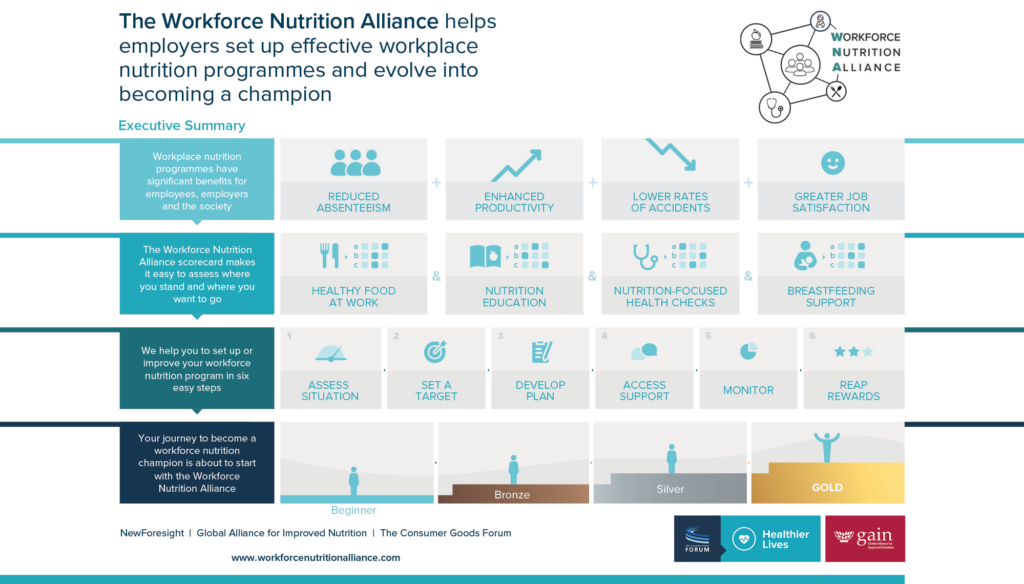8 December 2020 — Last year, The Consumer Goods Forum joined forces with the Global Alliance for Improved Nutrition (GAIN) to co-found the Workforce Nutrition Alliance (WNA), supported by NewForesight, with the aim of supporting employers to adopt and expand workforce nutrition programmes and impact 3 million employees in their organisations and supply chains by 2025. The WNA focuses on increasing employees’ access to healthy and safe foods at work, and helping them to adopt beneficial health habits.
Why is it important?
One in three people across the globe is malnourished. Being malnourished includes issues related to underweight, obesity, nutritional deficiencies, and non-communicable diseases. The general perception is that malnutrition is an issue relevant to low and middle-income countries, but the truth is that it exists across the globe across all income groups. A study across 19 countries estimates businesses lose an estimated $8–38 billion per year from reduced worker productivity due to employees being underweight, and $4–27 billion per year due to obesity. Further, the COVID-19 pandemic has reiterated the need for healthy employees for workplaces to operate efficiently.
Malnutrition has an impact on the individual’s health, businesses’ performance, and the economies. It is critical to solve this issue and the workplace is an optimal point of intervention as 58% of the global population will spend at least 1/3 of their adult lives at work. However, currently, only a small percent of the global workforce who work in corporate offices in high-income countries have access to healthy food options at work. Many employers in supply chains who provide food to meet a regulatory requirement are not necessarily offering nutritionally balanced meals and snacks. Food provided to low-income workers is often staple heavy and lacks fruits, vegetables, and proteins. This is a lost opportunity and often can be adjusted with minimal to no cost.
Most employers do not implement effective workforce nutrition programmes due to lack of awareness, perceived issues related to limited incentives, high resource requirement, and complex implementation:
- Lack of awareness: Employers have a limited understanding of the health and nutrition-related topics and their prevalence within their organisations and supply chains. There is a limited understanding of the impact of malnutrition on operations.
- Limited incentive: Employers see a limited incentive in investing in employee health, as this is not a requirement from customers and it does not feature as a critical issue that can create reputational risk. Further limited positive reinforcement in terms of subsidies or tax exemptions from the governments and low perceived value of the programmes by employees disincentivises employers.
- High resource requirement: Employers perceive designing and implementing workforce nutrition programmes to be resource-intensive in terms of funding requirements, bandwidth, and capabilities of existing teams.
- Complex implementation: Employers can have different types of workplaces (For example offices, factories, retail stores, farmlands) across regions. This means the infrastructure, socio-cultural practices, and preferences for foods can vary. Designing, implementing, and monitoring the progress across diverse workplaces and lack of a standardized approach complicates the process.
Why should you invest in solving this issue?
Despite the operational issues, workplace nutrition and health programmes must be implemented as they can have significant benefits for employees, employers, and society. Solving malnutrition through the workplace is expected to positively contribute to SDG 2 (zero hunger), SDG 3 (good health and wellbeing), and SDG 8 (decent work and economic growth).
The evidence on the benefits of workforce nutrition programmes for employers is compelling. Well-implemented strong programmes have shown to reduce absenteeism, improve productivity, lower rates of accidents & mistakes, lead to greater job satisfaction, and financial benefits through reduced medical costs (1,2). For example, a review of breastfeeding support programmes in the USA found a 3:1 return on investment for employers through cost savings (3). Less quantifiable, but nonetheless important benefits have also been reported from employers implementing such programmes, including improved brand reputation and talent retention (4). On the other hand, the cost of inaction can be stark with most employers being unaware of the losses on the longer term.
Also, the current COVID-19 situation stresses on the need for creating a healthier and resilient workforce. Workforce nutrition programmes enable employers to operate within their circle of influence and create a cascading impact.

How can you implement effective workforce nutrition programmes?
Workforce nutrition programmes are a set of interventions that work through the existing structures of the workplace to address fundamental aspects of health amongst all workers (direct employees and/or indirect workers in supply chains). Ideally, these programmes aim to create improved access to – and demand for – safe and nutritious food, to change employees’ behaviours around food consumption, and to improve their health and wellbeing. Breastfeeding support programmes are included in this definition.
Any employer can adopt or strengthen the workforce nutrition programs for their workforce. To support the employers and overcome existing challenges, the Workforce Nutrition Alliance makes the case for action and simplifies the implementation process for the employers. The Workforce Nutrition Alliance has identified four programmes that can yield effective results along with relevant actions for each of the four programmes. They have also designed a self-assessment tool to help employers assess their current performance and make SMART goals to improve their performance; and they provide implementation support programmes to employers to realize their goals.
The Workforce Nutrition Alliance supports employers through the journey to ensure real ground-level impact through the six-step process:
- Assess the current performance of the organisation: Use Workforce Nutrition Alliance’s online self-assessment tool
- Set a target: Make a pledge and outline SMART commitments to reach at least silver but preferably gold standard by 2025
- Develop a plan: To plan and integrate the required programmes in current operations within 1 year of making the pledge; identify clear targets and objectives on which to measure success along the way
- Access support: Receive implementation support programme from the Workforce Nutrition Alliance or access customised support from experts
- Monitor: Track and measure progress on annual basis and report it to the Workforce Nutrition Alliance
- Reap rewards: Reap the rewards of employing a healthier workforce
The journey to support your workforce can start today! Contact us for more information on how to get started: workforcenutrition@gainhealth.org or hw@theconsumergoodsforum.org

This blog was co-written and contributed by:
Yoshita Arora, NewForesight
Sharon Bligh, Healthier Lives Director, The Consumer Goods Forum
Christina Nyhus Dhillon, Senior Technical Specialist, Global Alliance for Improved Nutrition (GAIN)
References
- Wanjek, C. Food at work: workplace solutions for malnutrition, obesity and chronic diseases. (ILO, 2005).
- Berry, L. L., Mirabito, A. M. & Baun, W. B. What’s the hard return on employee wellness programs? Harv Bus Rev 88, 104–112, 142 (2010).
- Mills, S. P. Workplace Lactation Programs. AAOHN J 57, 227–231 (2009).
- Speelman, L. et al. Nutrition programmes for workers in commodity value chains: The business case. https://nutritionconnect.org/sites/default/files/2020-01/Garment%20study%20-%20GAIN%20and%20NewForesight_0.pdf.
